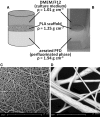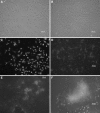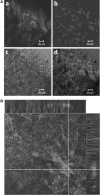Liquid perfluorochemical-supported hybrid cell culture system for proliferation of chondrocytes on fibrous polylactide scaffolds
- PMID: 24532258
- PMCID: PMC4141970
- DOI: 10.1007/s00449-014-1143-3
Liquid perfluorochemical-supported hybrid cell culture system for proliferation of chondrocytes on fibrous polylactide scaffolds
Abstract
CP5 bovine chondrocytes were cultured on biodegradable electrospun fibrous polylactide (PLA) scaffolds placed on a flexible interface formed between two immiscible liquid phases: (1) hydrophobic perfluorochemical (PFC) and (2) aqueous culture medium, as a new way of cartilage implant development. Robust and intensive growth of CP5 cells was achieved in our hybrid liquid-solid-liquid culture system consisting of the fibrous PLA scaffolds in contrast to limited growth of the CP5 cells in traditional culture system with PLA scaffold placed on solid surface. The multicellular aggregates of CP5 cells covered the surface of PLA scaffolds and the chondrocytes migrated through and overgrew internal fibers of the scaffolds. Our hybrid culture system simultaneously allows the adhesion of adherent CP5 cells to fibers of PLA scaffolds as well as, due to use of phase of PFC, enhances the mass transfer in the case of supplying/removing of respiratory gases, i.e., O2 and CO2. Our flexible (independent of vessel shape) system is simple, ready-to-use and may utilize a variety of polymer-based scaffolds traditionally proposed for implant development.
Figures




References
Publication types
MeSH terms
Substances
LinkOut - more resources
Full Text Sources
Other Literature Sources
Miscellaneous

